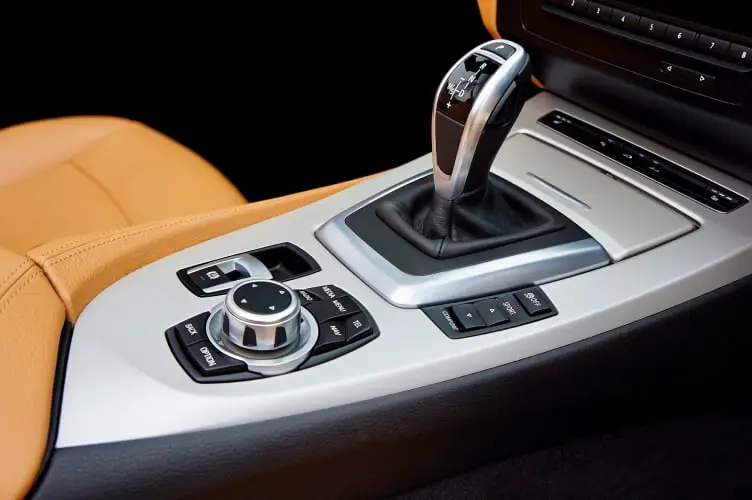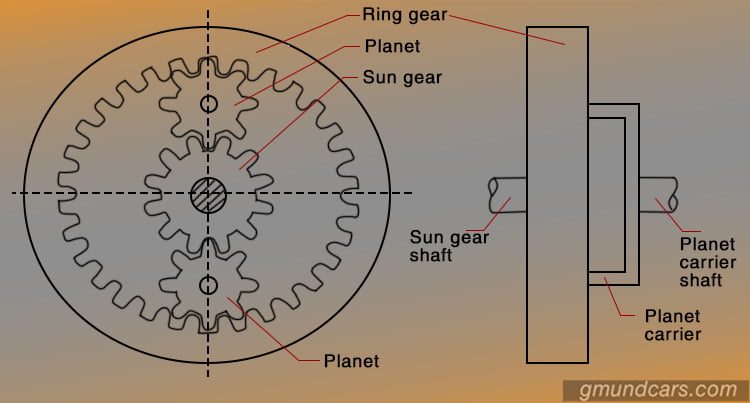The debate over automatic transmission versus manual transmission has been ongoing for quite a while. Hence, we’ve decided to contribute to this conversation by offering insightful information. Ordinarily, both manual and automatic transmissions, like any transmission system, are inherently complex. Each transmission operates differently due to intrinsic variances. In this detailed comparison, we’ll examine the distinctions between automatic and manual transmissions.
The following post serves as a guide, a useful reference, and an answer to questions that most people ask.
What Does A Transmission Do?
The transmission transfers engine power to the wheels to assist in a vehicle speeding up. It’s a vital engine component, ensuring that the wheels get enough energy. This way, the car can move at a certain speed.
It regulates the speed at which the engine spins and the rate at which the driving wheels move. The wheels move slower than the engine when the automobile is lower gear. But when the car is in a higher gear, the wheels move faster than the engine.
Automatic Transmission And Manual Transmission Comparison
Automatic Transmission And Manual Transmission Difference
| Automatic Transmission | Manual Transmission | |
|---|---|---|
| Structure | The components of an automatic transmission: - Torque converter - Planetary gear set - Pump - Stator - Turbine. | - The manual transmission system in cars consists of various parts. These components include the main shaft, a hub fitted to the main shaft's exterior circumference, and a transmission case. - It has a gear assembly connected to the hub within the system. The gear assembly consists of a planetary gear set and a first-speed clutch gear. The gear assembly also includes the planetary gear set having a ring gear, a sun gear, a pinion gear, and a planetary carrier holding its pinion gear. - The other systems are the synchronizer's sleeve, a cone, and a ring. |
| Operating principle | - The transmission control unit delivers signals to the torque converter control elements on the indicators. - The clutches in the planetary gear move with the transmission fluid at the proper pressure. The gear ratio therefore changes. The transport's speed determines the speed of this process. | - The first shaft's gear meshes with the gears of the other shaft. The total gear ratio for that gear depends on the ratio between the selected gear on the input shaft and the gear engaged on the output shaft. - The shift lever helps to engage gears in a manual gearbox system. The connections that regulate the movement of the gears along the input shaft contact the gears. - Two links are used in cars with four gears or speeds, while three linkages come in vehicles with five or six rates. You can alter the links by shifting the shift lever left and right. |
| Applications | - Cars with an automatic transmission are ideal for people who often drive in urban areas. Automatic vehicles tend to lessen a driver’s fatigue by not holding the clutch off or on continuously. - Most automatic cars lack hill descent control and hill hold control systems. Thus, they aren’t the best option for hilly grounds, as they may roll forward and back on hill starts. Drivers of such cars need a hand to prevent the car from rolling forward or backward, especially on bumpy roads. | - A vehicle with a manual transmission system fits the long-distance driver. Besides, its transmission system is perfect for anyone moving along faster roads. Formula One racing vehicles use a manual gearbox with rapid reaction shifting - The manual transmission is also perfect for those driving around on hilly roads. Thus, you don’t have to worry about stopping on descent or an incline. - Due to the flexibility to coast and upshift at any moment, manual gearboxes are also advantageous in adverse weather. MT comes on all heavy vehicles, such as trucks and loaders. |
| Types | Automatic transmissions are divided into two categories: - Dual-clutch automatic gearboxes - Traditional automatic transmissions | The manual transmission system can come in three unique types. They are: - Sequential manual transmission - Constant mesh gearbox - Unsynchronized transmission. |
| Fuel economy | - Automatic systems have a worse fuel efficiency than manuals and their higher price. Because the gearbox and torque converter are heavier, this is the case. - The more gasoline an automobile consumes, the more power it needs to move. | - Some advanced automatic transmissions can compete with manual models in fuel economy. However, a manual gearbox typically outperforms an automatic transmission when driven correctly. - It's due to lower power loss and the opportunity for drivers to adjust their driving for improved gas efficiency. |
| Acceleration | - Most automatic transmissions shift quicker and more precisely than stick shifts. - The distance between engagement clutches on most automatic gearboxes is just a few nanometers. Therefore, it means that an automatic could ideally shift faster than you can blink. | - Automobiles with manual transmissions accelerate faster. Even more, these cars weigh less. Plus, they waste less power than cars with automatic gearboxes. - A manual gearbox is generally the natural option for drivers who prefer high-performance vehicles. |
| Driving experience | - Some drivers miss the automatic transmission's changes and acceleration. As with typical automatic gearboxes, there is no ringing or sensation of the car shifting gears. - Even though the engine achieves the same speeds as a CVT, you only notice a mild humming or droning sound. | - Driving a manual vehicle requires effort and engagement. After all, you must pay attention to details such as proper pedal action. Drivers should also be keen on changing from clutch to gas to brake. You may even have to check more elements. - Driving a manual car might be a job rather than a pleasure for some drivers. A manual may not be the ideal option for you if you prefer relaxation and comfort above speed and performance. |
| Durability/Lifespan | Automatic gearboxes typically last between 100,000 and 200,000 miles, or around 7 years. Extreme lifespan and early failure are both possible scenarios. | A manual gearbox may go up to 120,000 miles before being replaced (about 5-6 years). Its lifetime may drop after aggressive driving and careless fluid changes. |
Read more: Dirty Transmission Fluid: Signs And Causes
Automatic Transmission And Manual Transmission Similarity

The Gearbox symbol’s similarity:
– The DRIVE setting shows as the letter D. D1, D2, and D3 are the three levels available. Depending on their pace, a driver changes to different levels.
– The PARK set refers to the letter P. All gears are locked when the gear shifter is at this position. It is the best gear for vehicle packing.
– The NEUTRAL setting means the letter N. One may use the gear when the car moves too slowly.
– The REVERSE setting is indicated by the letter R. The drive shaft shifts backward if the gear shifter is at this position. The vehicle can only go backward, not forwards.
– S – This signifies that the mode is SPORT.
– M – This suggests that the setting is MANUAL. The manual gear allows the driver to use paddle shifters to shift the transmission manually.
– The letter L stands for LOW DRIVE GEAR.
Read more: Bad Torque Converter Vs. Bad Transmission
Automatic Transmission Vs. Manual Transmission For Details
Automatic Transmission
Definition
People often abbreviate automatic transmission as AT or auto. It is a multi-speed gearbox used in cars. The system helps in changing forward gears without the need for human input.
Structure
Some drivers may refer to its structure as a transaxle. It is referred to as a transaxle because it combines a transmission, axle, and differential into a sole unit.
The major components of the automatic transmission include:
- The hydraulic control.
- The torque converter is the component that transmits power from the engine.
- The oil pump.
- The planetary gear has two inputs and one output. The planetary gear can cause gear reduction.
- The valve body.
Types
The three types of automatic transmission are:
- Dual-clutch transmissions
- Automated manual transmissions
- Electronically controlled transmissions
Operating principle

An automatic transmission comprises three parts: a sun gear, a pinion or planet gear, and a ring gear. More so, the brake encloses the ring gear with teeth on its inner circumference. The hydraulic pressure exerted by the hydraulic oil operates the braking band. It changes per an electronic sensor or movement with vehicle speed, load, and the opening of the accelerator valve. The planet gears are always in mesh with the sun and ring gears. In addition, they can freely revolve on their axes, which links the carrier frame. In this case, the frame attaches to the driving shaft. The rotating sun gear drives the planet gears to turn while the braking band locks the ring gear. Because the ring gear is immovable, it forces the planet’s gears to climb over it.
The ring gear serves as a path for the planet gears to go over while in this configuration. As a result, the driven shaft, which links the planet gear carrier, rotates. When the ring gear is free, it can move freely in response to the rotation of planet gears rotating around their axis. There is no planet movement carried in this position. Therefore, the driven shaft remains fixed.
Read more: CVT Transmission Vs. Automatic Transmission
Manual Transmission
Definition
People often label these transmissions as manual gearboxes. Others may call it the standard transmission. Its other name is the stick shift. Besides, it is multi-speed auto transmission. The driver selects the ratios manually. Even more, he sets them using a gear stick and clutch.
Structure

A manual transmission comprises different components. These parts include the shafts, gears, and selecting mechanisms. Here, their arrangement provides suitable speed. It also offers the ideal torque ratios to meet the challenges of any road.
Types
Let’s look at the types of transmissions. Have you heard of Sequential manual transmission or constant mesh gearbox? These are kinds of manual transmissions. The major types of these manual systems include:
– Constant-mesh gearbox
– Sequential manual transmission
– Unsynchronized transmission
Operating principle
The input and output shafts and a set of gears make up the workings of a manual transmission system. The first shaft’s gear meshes with the other shaft’s gear. The total gear ratio for that gear varies with the balance between the selected input shaft gear and the gear set on the output shaft.
The shift lever helps to engage gears in a manual gearbox system. The connections that regulate the motion of the gears somewhere on the input shaft contact the gears. Two links are used in cars with four gears or speeds, while three linkages come in vehicles with five or six rates. You can alter the links by shifting the shift lever left and right.
A Clutch is vital in the operation of a manual transmission. Besides, it disconnects the engine from the transmission’s input shaft when pressed. As the engine sends torque through the input shaft, it frees the gears on it, allowing it to move freely.
When the clutch lever is free, the clutch is said to be detached. The driver may select the gear and release the grip once the clutch disables the engine power to the transmission. When one released the clutch, engine power was redirected to the input shaft, causing the automobile to move at the specified gear ratio.
Read more: How Long Does Transmission Last?
Automatic Transmission Vs. Manual Transmission: Which One Should I Buy?
Automatic transmissions are, in general, simpler to use and more pleasant for the driver. In contrast, manual transmission cars are less costly and require more effort. Of course, each rule has exceptions. Thus, the only way to know which one is suitable for you is to take a test drive.